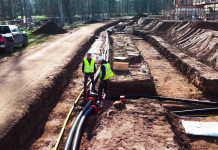RWE is partnering with Offshore Renewable Energy (ORE) Catapult to study the potential for Scottish businesses to produce commercial scale concrete foundations for floating wind projects. The possible development of floating wind projects in Scotland puts a focus on the amount of local content that could be achieved: this report aims to set out what would be required to deliver this.
Manufacture of concrete foundations could have the biggest supply chain benefit in terms of Scottish content for floating wind projects. In recent years, the Scottish engineering supply chain has been an industry leader, delivering huge oil and gas structures for the North Sea, as well as exporting technical expertise to markets around the world. Here is potential to build on this legacy, for example, one concrete foundation for a 15MW floating turbine would have a mass in excess of 10,000 tonnes; a 500MW project would need around 33, offering an important opportunity for the local supply chain.
The study will be carried out by the Offshore Renewable Energy (ORE) Catapult’s Floating Offshore Wind Centre of Excellence to understand the scale of this potential and how it might be unlocked.
ORE Catapult’s FOW CoE programme manager, Ralph Torr, said, “This report will identify key manufacturing and fabrication methodologies and constituent materials required to produce concrete substructures. It will also assess the existing Scottish supply chain capability and capacity to deliver such concrete substructures into a utility scale floating offshore wind project.
“Floating wind will be required to exploit a significant proportion of the deeper Scottish waters identified by Marine Scotland’s latest Offshore Wind Sector Marine Plan, and hence play a key role in Scotland achieving its Net Zero target by 2045.”
Fully funded by RWE and delivered as a discretionary project within the Floating Offshore Wind Centre of Excellence, a summary of the work will be published upon completion of the research in mid-2021.
Alongside RWE’s three floating wind demonstration projects the company is actively seeking new offshore wind opportunities off the coast of Scotland to complement the recently announced four extension projects and 3GW success in the Crown Estate Round 4 Leasing Round in the UK.
The company is a founder member of the Carbon Trust’s Floating Wind Joint Industry Project and member of ORE Catapult’s Floating Wind Centre of Excellence.
The knowledge gained from the three floating offshore demonstration projects RWE is participating in, provides an important source of information for future projects;
- The 2MW DemoSATH project, being developed in partnership with Saitec Offshore Technologies, is planned to be launched off the north coast of Spain in 2022.
- The 12MW New England Aqua Ventus (NEAV) project, being developed in partnership with Diamond Offshore Wind and the University of Maine, is planned to be deployed in 2023 in the USA off the coast of Maine.
- RWE’s third floating demonstration project, using the steel TetraSpar concept, being developed in partnership with Stiesdal Offshore Technologies, Shell and TEPCO, is expected to be launched later in 2021.



